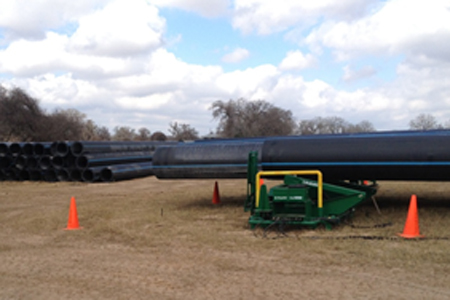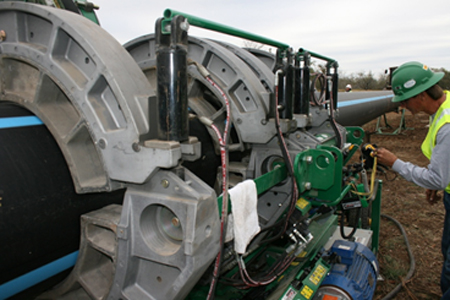New 23-Mile San Antonio Water Pipeline Wins Industry Award
A water pipeline extension recently completed for the San Antonio Water System (SAWS) is the largest high-density polyethylene (HDPE) pipe project of its type ever done in North America according to the Plastics Pipe Institute, Inc. (PPI). The $149 million, Regional Carrizo Project undertaken to provide water to 60,000 homes by late 2013, was named Project of the Year for PPI's Municipal and Industrial Division. PPI is the major trade association representing all segments of the plastic pipe industry.
The potable water transmission project was done to provide a long-term solution for the water supply of San Antonio, one of the fastest-growing areas in the United States. The city currently receives more than 90 percent of its water from the Edwards Aquifer. This project enables SAWS to also tap into the Carrizo Aquifer, located approximately 50 miles from San Antonio. Up to 13 million gallons per day (mgd) of water produced from this well field will be transported by the new HDPE pipeline to an integration point in northeast San Antonio where it will enter the SAWS distribution system. SAWS used more than 23 miles of HDPE pipe in 18, 24, 30 and 36 inch diameters to bring the water from the aquifer to an integration point where the water will enter the SAWS distribution system.
"For this Project of the Year, the numbers alone are exciting," stated Tony Radoszewski, executive director of PPI. "It used 122,000 feet of high-density polyethylene (HDPE) pipe ranging from 18 to 36 inches in diameter, which made it the largest HDPE water pipe project in North America. There were 328 truckloads of HDPE pipe made from PE 4710 resin that totaled some 11 million pounds. But it's not only the numbers. This project faced some staggering performance challenges. Because of the super-heated temperature of the water and soil, the project was originally designed to use steel and ductile iron pipe. But SAWS conducted additional analysis of the requirements that included longevity, installation, material and labor costs and the change was made to HDPE pipe. It installs quickly and easily, can stand up to virtually any environment for a projected lifespan of 100 years and delivers a highly-sustainable, leak-free system with fused joints."

Proper staging and supplying on demand was imperative for installation efficiency for a project as large as this, which used more than 122,000 feet of HDPE pipe. Here, a small portion of the pipe is ready to be fused.
Radoszewski presented the Project of the Year Award to member companies ISCO Industries (Louisville, Ky.) and Performance Pipe (Plano, Texas) during PPI's 2013 annual membership meeting. ISCO Industries is a pipe and equipment supplier and custom manufacturer HDPE piping products. It also provided the units and technicians who fused the pipe sections together. Performance Pipe, a division of Chevron Phillips Chemical Company LP, manufactured the pipe.
QC From Resin Plant to Field
Quality control was a concern for SAWS because of the average water and soil temperature of 98°F. ISCO provided the material certifications from the pipe manufacturer including traceability of the resin, and conducted in-field tensile strength testing of the pipeline on a McElroy DataLogger unit. McElroy Manufacturing, Inc. (Tulsa, Okla.) is also a PPI member company.

Quality control tests were also conducted in the field for the new SAWS water pipeline extension. An ISCO fusion technician logs information using a McElroy DataLogger
"Quality control and on-site testing were important issues for SAWS," said Camille Rubeiz, P. E., director of engineering for PPI’s Municipal Division. "These extra steps would have been very costly to do for coated steel pipe. HDPE proved to be a leak-free material, with no cathodic protection required, leading to lower maintenance costs, which was critical given the remote location of the project. SAWS especially liked the projected 100 year life and the environmentally-friendly nature of HDPE in general. The pipe's ability to bend saved money because there were fewer elbows to purchase. The durability of HDPE allowed it to curve and maneuver around trees and obstructions, causing minimal environmental disturbance. Also, the ability to fuse pipe above ground in long lengths ahead of the installation crew allowed for lower overall cost and less work in the ditch, therefore making it safer."
The pipe was made from PE 4710, an advanced grade of HDPE resin and was selected for its high temperature and pressure capacity. According to the Rubeiz, "PE 4710 allows for the maximization of pipe performance in a system, bringing an excellent level of slow crack growth resistance and enabling a piping system to be operated at high pressure and temperatures without sacrificing safety or service life. Use of PE 4710 also permitted different dimensional ratio (DR) rating ranges of the pipe to be used which maximized cost savings."
The total length was 122,149 feet in these sizes and DR ratings:
- 34,765 feet – 18-inch DR-9 PE4710
- 34,364 feet – 24-inch DR-9 PE4710
- 9,256 feet – 30-inch DR-9 PE4710
- 24,571 feet – 36-inch DR-11 PE4710
- 9,825 feet – 36-inch DR-13.5 PE 4710
Materials also included many flange adapters and SS316 back-up rings and custom fabricated and standard HDPE fittings. ISCO also provided the fusion machines.
This is one the largest municipal applications of HDPE pipe and one of many SAWS projects using the product," Radoszewski said. "Since it began it was an uncommon project in size, scope and application. Many people from different parties were involved in the material selection and all were convinced that HDPE pipe was the best choice. This PPI Project of the Year will serve as a proven example of the successful use of the pipe in a large project that also had extreme requirements. Now an industry benchmark, it will help increase widespread use and adaption of HDPE piping materials to other large-scale municipal projects."
For more information, visit the Plastics Pipe Institute website: www.plasticpipe.org.
About PPI:
The Plastics Pipe Institute Inc. (PPI) is the major trade association representing all segments of the plastic pipe industry and is dedicated to promoting plastics as the material of choice for pipe applications. PPI is the premier technical, engineering and industry knowledge resource publishing data for use in development and design of plastic pipe systems. Additionally, PPI collaborates with industry organizations that set standards for manufacturing practices and installation methods.
